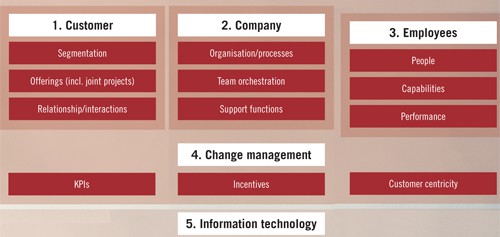
Since 2003, Siemens – the global powerhouse in electrical engineering and electronics – has won the Strategic Account Management Association (SAMA) Program of the Year Award three times. In 2011, SAMA President and CEO Bernhard Quancard explained: “Siemens impressed us with its ongoing cultivation of customer relationships, its fostering of promising and talented sales employees and its practical implementation of customer proximity at the Managing Board level.”
It is not just the number of awards which are increasing as a result. From 2011 to 2013, the 1,200 Strategic Account Managers at Siemens were instrumental in increasing company revenues from 40 to 51%. This remarkable success is driven by Siemen’s ongoing investment in further expanding the key account management system, the provision of training and continuing education for sales employees and development of improved software for managing customer processes.
That is all very well, you might say, but Siemen’s sells electronics not pharmaceuticals – and they do not have to contend with the ‘fourth hurdle’ to market access, namely the need to demonstrate cost effectiveness. But we would argue that if anything, this is even more reason to establish meaningful relationships and joint value creation with healthcare providers. Just recently we have seen the impact of ‘surprise’ pricing on healthcare providers, with some of the largest US customers threatening revolt over the pricing of hepatitis C drug Sovaldi.
The rise of key healthcare accounts – and why they need managing
Let’s take a step back. Historically, the pharma sector was able to focus on demand generation after obtaining marketing authorisations for its drugs. But today, it is difficult to find the individual decision-maker who can make an autonomous drug prescription decision given the widespread influence of powerful healthcare institutions, such as large provider networks, hospital and regional payers.
A set of trends related to managing and competing in healthcare and most importantly its financing, have been driving the rising importance of institutional accounts. For example, specialisation within healthcare delivery has led to globally-operating healthcare providers, such as Fresenius Medical Care, which provides dialysis services to more than 280,000 patients worldwide. Many other med-tech companies have followed the Fresenius example.
Within countries, regionalisation of healthcare systems has led to powerful regional payers. In rare diseases, the best specialised providers have concentrated virtually all national patient treatments in one centre. When patients pay for healthcare services out-of-pocket, they have been driving the formation of (ambulatory) chains focusing on superior outcomes, affordable costs and outstanding convenience.
Bearing all that in mind, an overall definition of a ‘key account’ could be: ‘A customer responsible for a significant part of the volume/ value for a selected product portfolio, justifying special focus by the pharma organisation in the field and beyond.’
A key account manager then has the vital role of strengthening and maintaining relationships with the key account, delivering tailored offerings, particularly through the implementation of joint projects. A long enough, cross-functionally coordinated effort should lead to the maximisation of the account’s revenue/ growth and increased customer satisfaction.
Healthcare accounts can be segmented based on needs
Having defined ‘key accounts’, we must then delve deeper to see what kind of key account we are dealing with – this very much depends on the needs of the institutions, which can vary significantly. Table 1 provides an overview of the three typical account segments – ‘drug price’, ‘healthcare costs’ and ‘total value’ – depending on their primary and secondary needs.
| Table 1: Healthcare account segments by primary and secondary needs | |||
| Healthcare account needs | Drug price | Healthcare costs | Total price |
| Drug cost management | Secondary needs | Primary needs | |
| Healthcare cost management | Secondary needs | Secondary needs | |
| Process improvement | Primary needs | Secondary needs | |
| Treatment quality improvements | Primary needs | Secondary needs | |
| Revenue enhancement | Secondary needs | ||
| Employee capability enhancement | Primary needs | Secondary needs | |
| Patient experience improvement | Secondary needs | ||
| Reputation/brand building | Secondary needs | ||
Some institutions still cite drug cost management as the most important factor. In these instances, pharma companies have to adopt stringent management of P&L investments to maintain profitability, including discounts/ rebates and services offered.
Fortunately, many healthcare accounts have more room for win-win collaborations, by focusing on total healthcare costs management (second column of the table). In these cases, pharmaceutical companies can align on key initiatives to manage healthcare costs together and measure progress jointly. Drug cost management and many other aspects are looked at as secondary needs.
The third column focuses on ‘total value’ and this is the most attractive to maximise joint initiatives together. These healthcare accounts enable pharma key account managers to act as business partners, by prioritising primary needs and formulating concrete objectives for each, such as well-defined and jointly implemented treatment protocols. Pharma companies managing ‘total value’ key accounts should be able to advance a set of strategic objectives, such as better account transparency/ understanding, optimal access to account patient pools, preferred co-operation/ engagement in projects and superior loyalty/ relationships.
Implementing KAM excellence frameworks
Our KAM excellence framework addresses all the key levers that pharma companies need to pull over time.
Initially, the most important aspects relate to customers, company and employees. In addition to creating the KAM role within the organisation, processes need to address several steps.
- Create unique insights by engaging an account and align on common objectives
- Develop concrete initiatives together with the account and achieve joint commitment
- Implement and track the collaborative progress of initiatives and distil key lessons learnt
- Develop priority initiatives/ programmes to be scaled across accounts/ countries
However, the largest hurdle to KAM Excellence is probably change management driving customer centricity. It is not sufficient to create a novel KAM role to interact directly with selected stakeholders and coordinate interactions indirectly with others, while influencing/ triggering interactions with a third set of stakeholders.
The quest for customer centricity triggers significant changes across a pharma organisation, both at country as well as corporate levels. As part of large-scale KAM Excellence programmes, pharma companies often identify second order effects, such as fundamental changes to their marketing operations to reflect the co-creation of value with key accounts together.
Quick-wins are needed to gain the momentum for the journey
Clearly, many pharma companies have already embarked on the journey to KAM Excellence. Often, first steps consist of defining a KAM Excellence framework at the global / regional level, implemented systematically with country organisations. Newcomers to the KAM approach often spend time identifying KAM best practices within and beyond the pharma sector, distilling key lessons learnt and sharing these within the organisation. Others start by comparing themselves through a systematic (self-)assessment to develop a tailored implementation roadmap.

An alternative approach focusing on KPIs has led to quick-wins due to strong involvement of key accounts from the outset. In one pharmaceutical company, after defining a set of KPIs reflecting the specific account archetypes, country organisations started engaging account executives to prioritise their institution’s needs, a first activity-based KPI mandatory for all accounts/ KAMs. Healthcare account executives welcomed the approach: “[It] is the only pharma company that ever exposed itself to this kind of assessment,” said one.
This led to the perception that the company distinguished itself from competitors in the way it does business with accounts, explaining the substantial quick-wins already generated during the pilot with the first 50+ accounts across five continents. The compelling quantitative impact for accounts and the pharma company alike also led to a measurable increase in trust. Due to the positive experience, healthcare accounts now focus on some of the more intangible and relationship-based aspects compared to the initial focus on more tangible elements, such as costs. It might well be the ‘silver bullet’ approach to triggering value co-creation, by agreeing first on win-win objectives as the basis for joint initiatives that are being measured systematically through a common set of KPIs.




